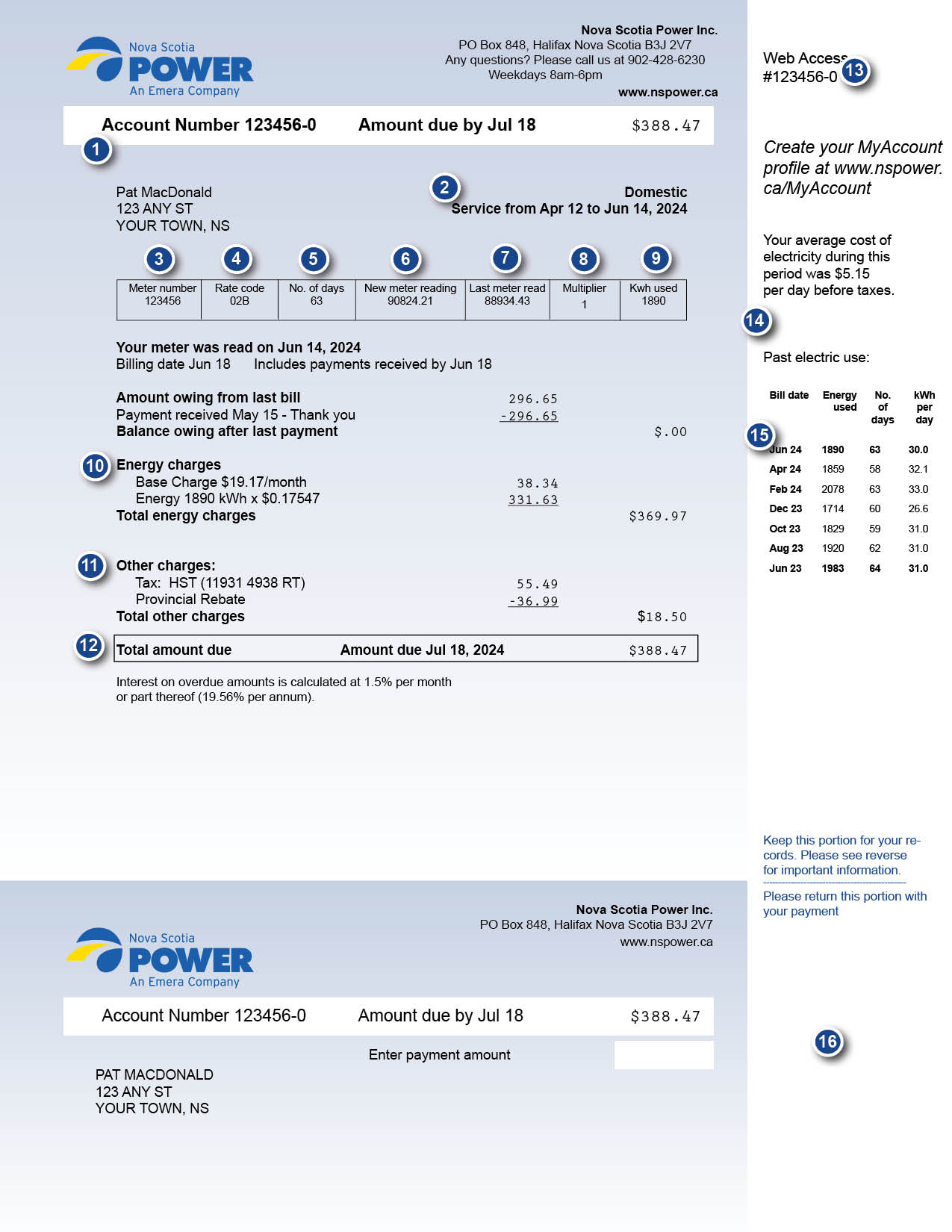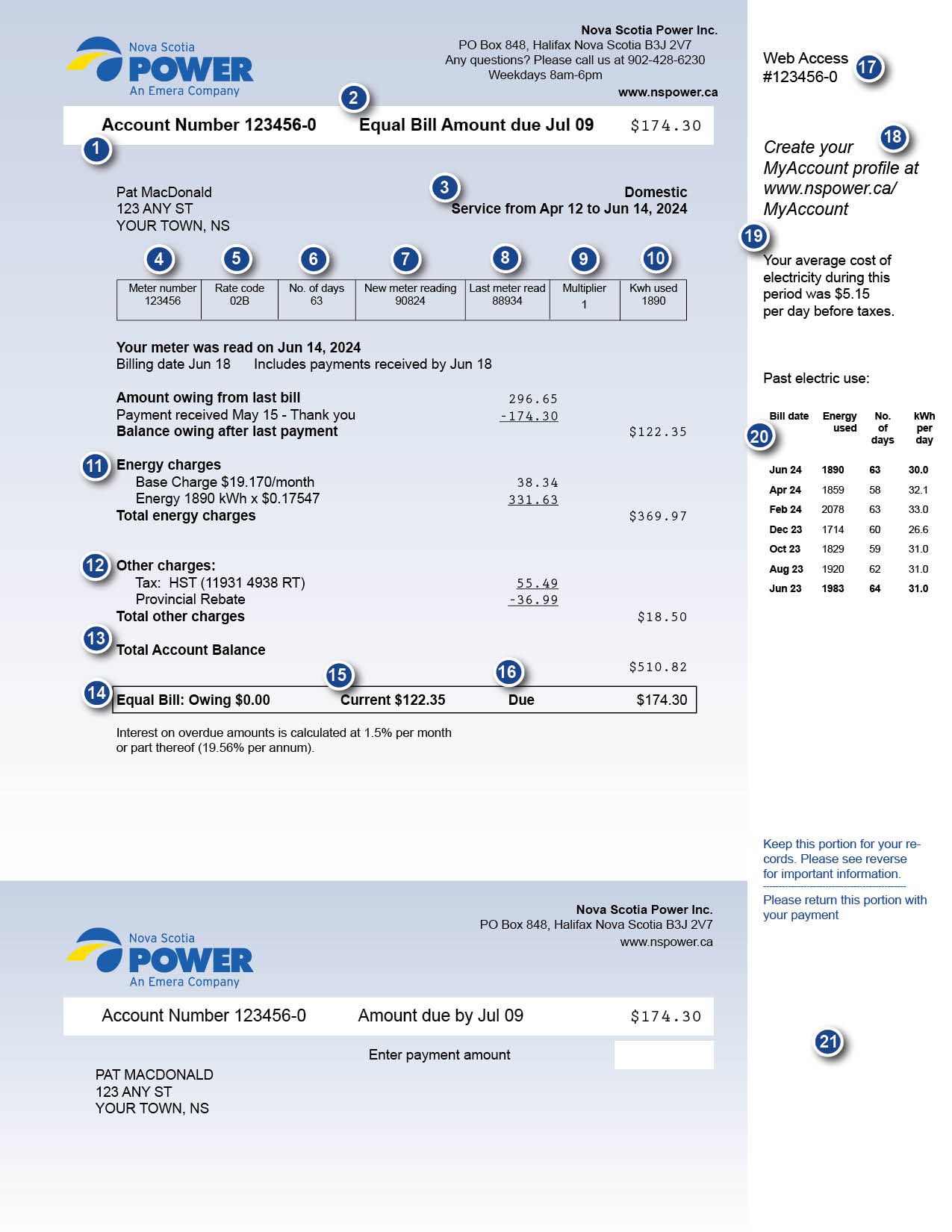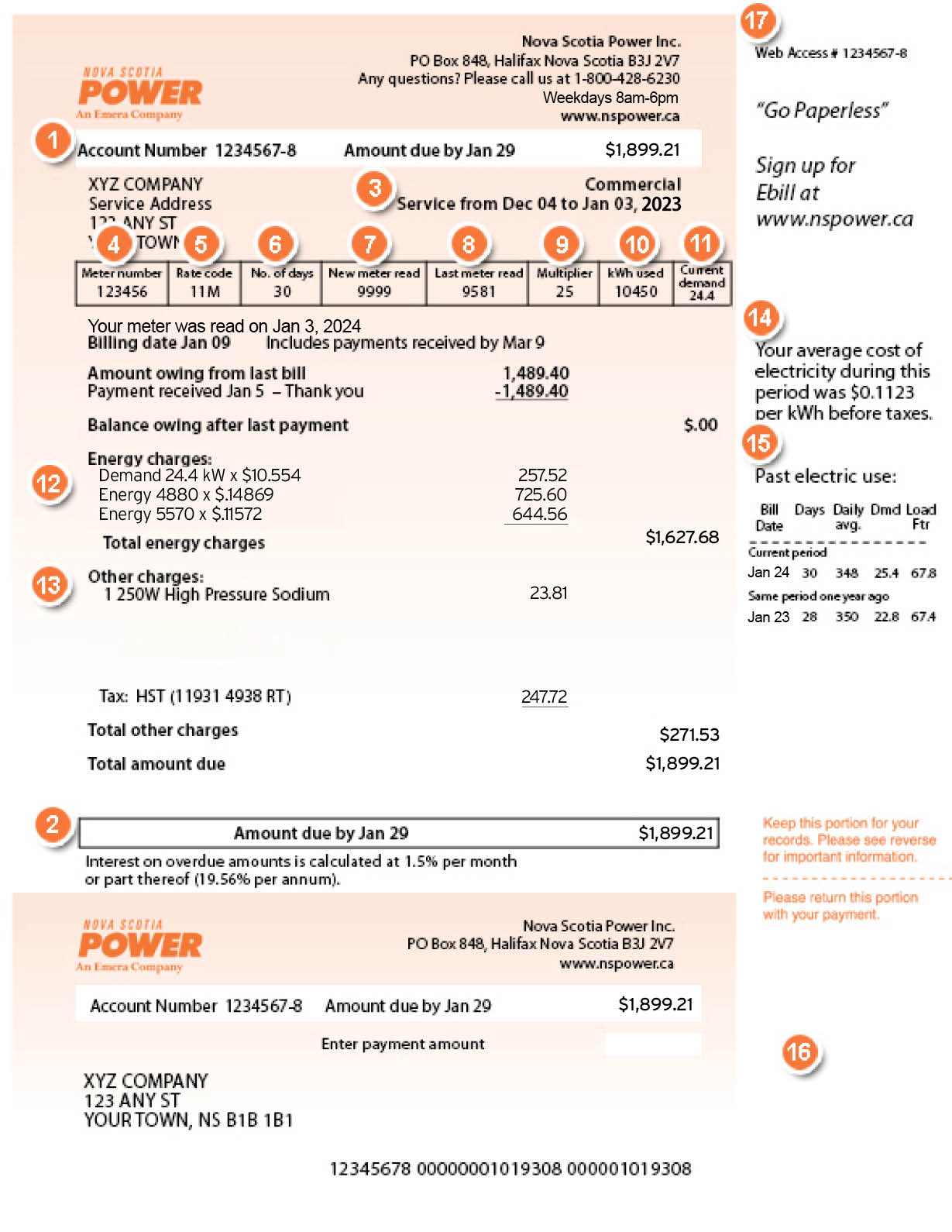Read Your Bill
We are actively responding to a cyber incident and working around the clock to restore all systems safely and securely.
We apologize for this inconvenience and thank you for your patience. We will post updates on nspower.ca as we make progress and restore all services.
Bi-monthly bill
Your power bill contains information to help you understand your energy use. This page contains descriptions of each element in the bill you receive on a standard bill, equal billing bill and demand bill.

1. Account Numbers
Account numbers are assigned to each new account. Your account remains the same even when the address changes for the account.
2. Service From
The dates of service covered by this bill.
3. Meter Number
This unique number identifies your meter. The meter number is usually six digits. No other meter has the same number.
4. Rate Code
Identifies the rate classification used for billing your service.
5. No. of Days
Total number of days in this billing period.
6. New Meter Reading
Your most recent meter reading for the meter listed.
7. Last Meter Reading
Your meter reading at the time of your last billing or connection. Subtract this from your present reading to determine the amount of electricity used during this billing period.
8. Multiplier
The amount of electricity used is determined by multiplying the difference between the present and previous reading by the multiplier shown on your electric bill.
9. kWh Used
The total number of kilowatt hours used during this billing period.
10. Energy Charges
A breakdown of your energy charges in kilowatt-hour usage for the current billing period.
As of January 1, 2024, the energy charge has changed.
11. Other Charges
This section shows any applicable charges for streetlights, water heaters, or heating systems financed through Nova Scotia Power, service charges, adjustments, taxes, etc.
12. Please Pay By
The date and amount of the total payment due. This amount includes current charges plus any arrears or credits.
If you are having trouble paying your bill in full, you can request a payment arrangement online through our Make a Payment Arrangement form within MyAccount or give us a call at 1-800-428-6230.
13. Web Access Number
You use this number to register for paperless billing to receive a convenient summary of your bill emailed directly to your inbox. The email notification provides your amount owing, payment due date, and the option to log in to MyAccount to view your full bill and gain valuable insights into your energy use. To take advantage of paperless billing, sign up for MyAccount. It’s free and easy to do.
14. Your Average Cost
A calculation of your average daily cost for electricity. Through MyAccount, you can have access to MyEnergy Insights—a digital tool that shows you how you use your daily energy use. With this tool, you have more control over your energy use and your power bill. Sign up for MyAccount to access MyEnergy Insights.
15. Past Electric Use
This is a 12-month overview of your average daily usage for the past year.
16. Remittance Stub
Detach this piece and send it in if you are mailing in a cheque. We offer several secure and convenient ways to pay your bill. Find the one that’s right for you.
Equal BILLING

1. Account Numbers
Account numbers are assigned to each new account. Your account remains the same even when the address changes for the account.
2. Equal Bill Amount due
This is the date and amount of the total payment due. This amount includes the current equal billing amount due as well as any equal billing amounts from previous months still owing.
3. Service From
The dates of service covered by this bill.
4. Meter Number
This unique number identifies your meter. The meter number is usually six digits. No other meter has the same number.
5. Rate Code
Identifies the rate classification used for billing your service.
6. No. of Days
Total number of days in this billing period.
7. New Meter Reading
Your most recent meter reading for the meter listed.
8. Last Meter Reading
Your meter reading at the time of your last billing or connection. Subtract this from your present reading to determine the amount of electricity used during this billing period.
9. Multiplier
The amount of electricity used is determined by multiplying the difference between the present and previous reading by the multiplier shown on your electric bill.
10. kWh Used
The total number of kilowatt hours used during this billing period.
11. Energy Charges
A breakdown of your energy charges in kilowatt-hour usage for the current billing period.
As of January 1, 2024, the energy charge has changed.
12. Other Charges
This section shows any applicable charges for streetlights, water heaters, or heating systems financed through NS Power, service charges, adjustments, taxes, etc.
13. Total Account Balance
This provides the total charges for electricity used up to the current billing date but not covered (paid for) by the monthly equal billing amount. Keeping track of this amount through the year can help you determine if your monthly Equal Billing payments are enough to cover the charges for electrical service that you've used.
14. Equal Bill Owing
This is an equal billing amount that remains unpaid from previous months.
15. Current
This is the current month's equal billing charge.
16. Due
This is the total equal billing amount due to be paid. It is a total of the Equal Bill Owing and Current.
17. Web Access Number
You use this number to register for paperless billing to receive a convenient summary of your bill emailed directly to your inbox. The email notification provides your amount owing, payment due date, and the option to log in to MyAccount to view your full bill and gain valuable insights into your energy use. To take advantage of paperless billing, sign up for MyAccount. It’s free and easy to do.
18. Bill Message
Important messages are printed in this area, including information on rate changes.
19. Your Average Cost
A calculation of your average daily cost for electricity. Through MyAccount, you can have access to MyEnergy Insights—a digital tool that shows you how you use your daily energy use. With this tool, you have more control over your energy use and your power bill. Sign up for MyAccount to access MyEnergy Insights.
20. Past Electric Use
This is a 12-month overview of your average daily usage for the past year.
21. Remittance Stub
Detach this piece and send it in if you are mailing in a cheque. We offer several secure and convenient ways to pay your bill. Find the one that’s right for you.
Demand Billing

1. Account Numbers
Account numbers are assigned to each new account. Your account remains the same even when the address changes for the account.
2. Please Pay By
The date and amount of the total payment due. This amount includes current charges plus any arrears or credits.
3. Service From
The dates of service covered by this bill.
4. Meter Number
This unique number identifies your meter. The meter number is usually six digits. No other meter has the same number.
5. Rate Code
Identifies the rate classification used for billing your service.
6. No. of Days
Total number of days in this billing period.
7. New Meter Reading
Your most recent meter reading for the meter listed.
8. Last Meter Reading
Your meter reading at the time of your last billing or connection. Subtract this from your present reading to determine the amount of electricity used during this billing period.
9. Multiplier
The amount of electricity used is determined by multiplying the difference between the present and previous reading by the multiplier shown on your electric bill.
10. kWh Used
The total number of kilowatt hours used during this billing period.
11. Current Demand
Your highest 15-minute interval average demand at any time during the billing period (the demand charge).
12. Energy Charges
Your demand charge is based on the highest rate of consumption during the billing period (see "11. Current Demand") and multiplied by the applicable demand charge.
There are 3 components to the calculation of a General Rate 11 bill:
Demand charge
+ First energy block charge
+ Second energy block charge
As of January 1, 2024, the energy charge has changed.
13. Other Charges
This section shows any applicable charges for streetlights, water heaters, or heating systems financed through NS Power, service charges, adjustments, taxes, etc.
14. Your Average Cost
A calculation of the average daily cost of electricity. Through MyAccount, you can have access to MyEnergy Insights—a digital tool that shows you how you use your daily energy use. With this tool, you have more control over your energy use and your power bill. Sign up for MyAccount to access MyEnergy Insights.
15. Past Electric Use
A comparison of your usage over the past year including demand and load factor. Note, a high load factor indicates steady usage whereas a low load factor indicates the recorded demand was not present for very long.
16. Remittance Stub
Detach this piece and send it in if you are mailing in a cheque. We offer several secure and convenient ways to pay your bill. Find the one that’s right for you.
17. Web Access Number
You use this number to register for paperless billing to receive a convenient summary of your bill emailed directly to your inbox. The email notification provides your amount owing, payment due date, and the option to log in to MyAccount to view your full bill and gain valuable insights into your energy use. To take advantage of paperless billing, sign up for MyAccount. It’s free and easy to do.


